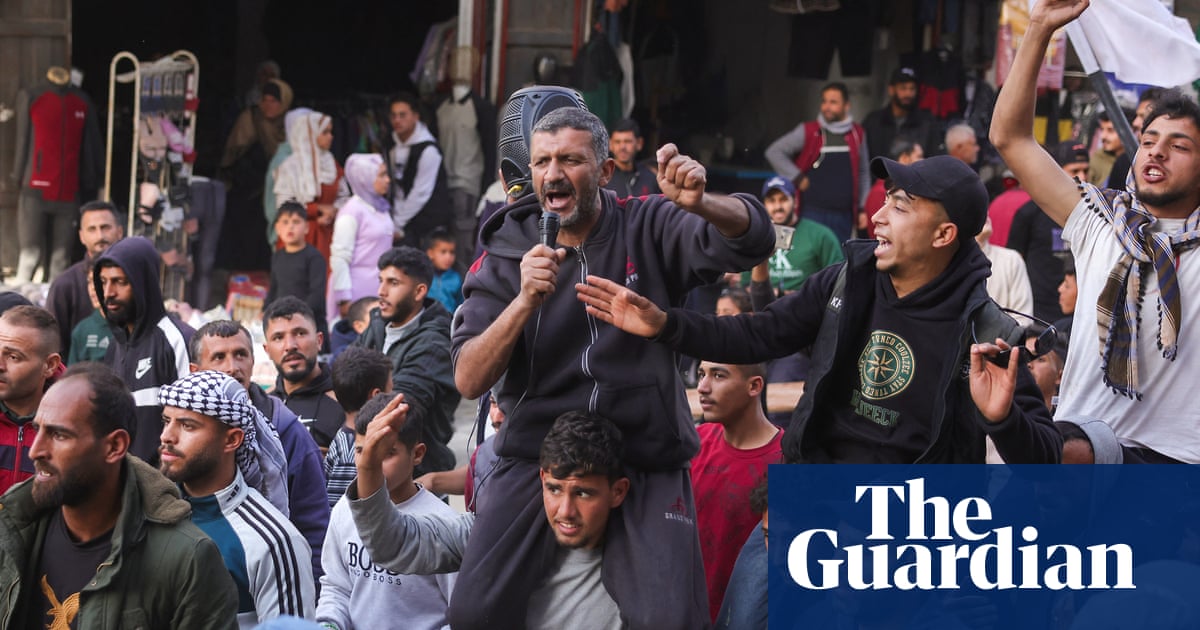Gazans Publicly Voice Frustration with Hamas Amidst Ongoing Conflict
Table of Contents
- 1. Gazans Publicly Voice Frustration with Hamas Amidst Ongoing Conflict
- 2. Unprecedented Protests Erupt in Gaza
- 3. Inside the Protests: Voices of Dissent
- 4. Past Context and Hamas’s Response
- 5. The Broader Context: War, humanitarian crisis, and International Pressure
- 6. Analysis: Implications and Potential Outcomes
- 7. What are the potential outcomes of these protests on Hamas’s power and control in Gaza?
- 8. Interview: Analyzing the Growing Unrest in Gaza
- 9. Understanding the Protests
- 10. Voices of Dissent and Underlying Factors
- 11. Hamas’s Response and Potential Outcomes
- 12. The Broader Context and Humanitarian Crisis
- 13. Geopolitical Implications and future Considerations
By archyde.com News Team | Published March 26,2025
Public discontent simmers in Gaza as residents stage rare protests against Hamas,demanding an end to the prolonged war with Israel. The demonstrations highlight the growing desperation and humanitarian crisis within the territory.
Unprecedented Protests Erupt in Gaza
In a rare display of public dissent, hundreds of Palestinians in northern Gaza took to the streets on Tuesday, March 25, 2025, to voice their frustration with Hamas, the ruling faction in the Gaza Strip. The protests, considered the largest against Hamas since the initial attacks of october 7, 2023, saw demonstrators chanting anti-Hamas slogans and calling for an immediate end to the ongoing conflict with Israel.
Videos and photos circulating on social media showed primarily men gathering in Beit lahia,shouting,Hamas out
and Hamas terrorists.
the location near the Indonesian hospital is notable, perhaps chosen for its visibility and relative safety, though no area in Gaza is truly safe currently.
The timing of the protests is also critical, occurring a week after the Israeli military resumed intense bombing of Gaza following a nearly two-month truce. This resumption of hostilities, coupled with the already dire humanitarian situation, appears to have pushed Gazans to their breaking point.
Inside the Protests: Voices of Dissent
Protesters carried banners with slogans such as stop the war
and We want to live in peace,
underscoring their desire for an end to the cycle of violence and deprivation. The protests appear to have been organized, at least in part, through social media platforms like Telegram, highlighting the role of digital communication in mobilizing dissent, even in environments with restricted freedoms. The use of Telegram, a platform known for its encrypted messaging, suggests that organizers were wary of potential surveillance by Hamas.
One man who participated, speaking to agence France-Presse (AFP), stated, I don’t know who organised the protest. I took part to send a message on behalf of the people: Enough with the war.
He also noted that he witnessed members of the Hamas security forces in civilian clothing breaking up the protest,
a tactic reminiscent of crowd control strategies used worldwide, including instances in the U.S.,during protests related to economic inequality or racial justice were plainclothes officers are deployed to monitor and disrupt gatherings.
Another protester, identified only as Majdi, expressed a sentiment echoed by many in Gaza, stating, the people are tired.
He further questioned, If Hamas leaving power in Gaza is the solution, why doesn’t Hamas give up power to protect the people?
This statement encapsulates the core dilemma faced by Gazans: the desire for peace and security clashing with the reality of Hamas’s continued control.
Similar demonstrations also occurred in the Jabalia refugee camps in western Gaza City, where dozens of people burned tires and chanted, We want to eat.
This simple yet powerful demand highlights the desperate conditions and food shortages plaguing the Gaza Strip.
Past Context and Hamas’s Response
These recent protests draw parallels to the Bidna N’eesh
(‘We Want to Live’) movement that emerged during the 2019 Gaza economic protests. Like the current demonstrations, those protests were driven by economic hardship and a desire for a better life. Though, as was the case in 2019, Those protests were violently suppressed by Hamas,
who accused the movement of being orchestrated by its rival, Fatah.
Hamas’s history of suppressing dissent raises concerns about how it will respond to these latest protests. The presence of security forces, even in civilian clothes, suggests that Hamas is closely monitoring the situation and is prepared to use force if necessary.this is similar to scenarios seen in the U.S., where law enforcement response to protests can range from de-escalation tactics to the use of riot control measures, depending on the perceived threat.
The Broader Context: War, humanitarian crisis, and International Pressure
The protests occur against the backdrop of a devastating conflict that has ravaged the Gaza Strip for over 17 months.The humanitarian situation is dire,exacerbated by the ongoing blockade and restrictions on aid entering the territory. The gaza Strip has been devastated by more than 17 months of war between Israel and Hamas, with the humanitarian situation again deteriorating after Israel blocked the passage of aid into the territory on 2 March in an attempt to force the militants to release Israeli hostages.
The war was ignited by Hamas’s attacks on southern Israel on October 7, 2023, resulting in the deaths of 1,218 people, mostly civilians, according to AFP tallies. Israel’s retaliatory military offensive has reportedly killed at least 50,021 people in Gaza, mostly civilians, according to the health ministry. These figures, while difficult to independently verify, underscore the immense human cost of the conflict.
Israel regularly calls for people in Gaza to mobilize against Hamas, which has been in power in the territory as 2007. Though, the reality is far more complex. Many Gazans are caught between their desire for peace and security and their fear of retribution from Hamas.
Analysis: Implications and Potential Outcomes
The protests represent a significant challenge to Hamas’s authority in Gaza. While it is difficult to predict the long-term impact, several potential outcomes are possible:
- Increased Repression: Hamas may respond with increased repression, further limiting freedoms and cracking down on dissent. This could led to more violence and instability.
- Limited Concessions: Hamas could make limited concessions to appease the population, such as easing some restrictions or increasing aid distribution. However,it is unlikely to relinquish power entirely.
- Escalation of Conflict: The protests could escalate into a larger uprising, potentially leading to a full-scale conflict between Hamas and its opponents within Gaza.
- International Intervention: The protests could increase international pressure on both Israel and Hamas to find a lasting solution to the conflict and address the humanitarian crisis in gaza.
For U.S. readers, these events underscore the complexities of the Israeli-Palestinian conflict and the challenges of promoting democracy and human rights in the region. The situation in Gaza highlights the importance of humanitarian aid and the need for a political solution that addresses the needs and aspirations of both Israelis and Palestinians.
These events highlight how internal conflicts, even within groups designated as terrorist organizations, can dramatically shift the landscape of geopolitical negotiations. It’s a lesson learned repeatedly,from the internal strife within Al-Qaeda post-9/11 to factions vying for power within ISIS. Understanding these dynamics is crucial for informed policymaking.
What are the potential outcomes of these protests on Hamas’s power and control in Gaza?
Interview: Analyzing the Growing Unrest in Gaza
Interviewer: Welcome to Archyde News. Today, we have Dr. Lena Hassan, a geopolitical analyst specializing in Middle Eastern affairs, to discuss the recent protests against Hamas in the Gaza Strip. Dr. Hassan, thank you for joining us.
Dr. Hassan: Thank you for having me. It’s crucial to analyze what is happening in gaza right now.
Understanding the Protests
Interviewer: the article highlights rare displays of public dissent in Gaza. Can you elaborate on the significance of these protests and why they’re happening now?
dr. Hassan: These protests are significant for several reasons. Firstly,they are a direct challenge to Hamas’s authority,which has ruled Gaza since 2007. public demonstrations on this scale are rare and signify a breakdown in the societal consensus once enjoyed by Hamas. The timing is also critical; they follow the resumption of intense Israeli bombings after a period of truce, coupled with an already devastating humanitarian crisis, pushing people to their limits.
Voices of Dissent and Underlying Factors
Interviewer: The article mentions slogans and sentiments expressed by protesters. What do these voices tell us about the underlying issues fuelling the unrest?
Dr. Hassan: The protesters’ messages are vrey clear: They’re tired of the war, the deprivation,and the lack of a future. The demand for basic necessities like food and the question of why Hamas doesn’t cede power to protect the people encapsulate the core grievances.These issues are compounded by the ongoing blockade, restrictions on aid, and the immense human cost of the conflict.
Hamas’s Response and Potential Outcomes
Interviewer: Given Hamas’s history of suppressing dissent, what are the likely responses and potential outcomes of these protests?
Dr. Hassan: The article suggests several possibilities. Hamas could increase repression, leading to further instability. They might offer limited concessions to appease the population, but it’s unlikely they would relinquish power entirely. There’s also the risk of the protests escalating into a larger internal conflict or even inciting further conflict between Gazan entities. International intervention is another possible outcome,increasing pressure on both sides to find a lasting solution.
The Broader Context and Humanitarian Crisis
Interviewer: How does the current humanitarian crisis in gaza contribute to the situation?
Dr. Hassan: The humanitarian situation is dire and is a significant factor. Over 17 months of conflict have devastated Gaza.There are shortages of essential supplies, limited access to basic services, and the blockade substantially restricts humanitarian aid. This desperation creates fertile ground for unrest and fuels public anger,making it critical to address the humanitarian needs of the population.
Geopolitical Implications and future Considerations
Interviewer: What are the broader geopolitical implications of these events?
Dr. Hassan: This internal conflict reveals the complexities of the Israeli-Palestinian conflict. These protests underscore that even groups designated as terrorist organizations have internal conflicts, which can dramatically shift power dynamics in the region.The events emphasize the need for humanitarian aid and a political solution addressing the needs of Israelis and Palestinians alike.The international community needs to increase pressure for peaceful resolution of conflict.
Interviewer: Dr. Hassan, do you have any closing thoughts for our readers, particularly those in the U.S. and elsewhere?
Dr. Hassan: Consider the long-term implications of continued conflict and humanitarian crises. What role shoudl the international community play, and how can we help ensure a more peaceful future? I encourage our readers to share their thoughts and engage in a constructive dialog about the future of Gaza. Its a place that desperately needs our help! Thank you for having me.
Interviewer: Dr. Lena Hassan, thank you for your insights on the current situation in Gaza. A valuable outlook that really brought the issues into focus.








